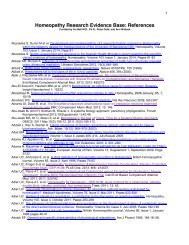core-operational-guidelines-for-telehealth-services
core-operational-guidelines-for-telehealth-services
core-operational-guidelines-for-telehealth-services
Create successful ePaper yourself
Turn your PDF publications into a flip-book with our unique Google optimized e-Paper software.
Core Operational Guidelines <strong>for</strong> Telehealth Services Involving Provider-Patient InteractionsPREAMBLEThe American Telemedicine Association (ATA) brings together diverse groups from traditional medicine,academia, technology and telecommunications companies, ehealth, allied professional and nursingassociations, medical societies, government, military, regulatory and others to overcome barriers to theadvancement of telemedicine through the professional, ethical and equitable improvement in healthcare delivery.ATA has embarked on an ef<strong>for</strong>t to establish practice <strong>guidelines</strong> <strong>for</strong> telemedicine to advance the science,to assure uni<strong>for</strong>m quality of service to patients, and to promote reasonable and in<strong>for</strong>med patient andprovider expectations. The <strong>guidelines</strong> are developed by panels that include experts from the field andother strategic stakeholders, and are designed to serve as both an <strong>operational</strong> reference and aneducational tool to aid in providing appropriate care <strong>for</strong> patients. The <strong>guidelines</strong> generated by ATAundergo a thorough consensus and rigorous review including an open public commentary period, withfinal approval by the ATA Board of Directors. Existing products are reviewed and updated periodically.The purpose of these <strong>guidelines</strong> is to assist practitioners in pursuing a sound course of action to provideeffective and safe medical care that is founded on current in<strong>for</strong>mation, available resources, and patientneeds. The <strong>guidelines</strong> recognize that safe and effective practices require specific training, skills, andtechniques, as described in each document. The resulting products are properties of the ATA and anyreproduction or modification of the published guideline must receive prior approval by the ATA.The practice of medicine is an integration of both the science and art of preventing, diagnosing, andtreating diseases. Accordingly, it should be recognized that compliance with these <strong>guidelines</strong> alone willnot guarantee accurate diagnoses or successful outcomes. If circumstances warrant, a practitioner mayresponsibly pursue an alternate course of action different from the established <strong>guidelines</strong>. A divergencefrom the <strong>guidelines</strong> may be indicated when, in the reasonable judgment of the practitioner, thecondition of the patient, restrictions or limits on available resources, or advances in in<strong>for</strong>mation ortechnology occur subsequent to publication of the <strong>guidelines</strong>. Nonetheless, a practitioner who uses anapproach that is significantly different from these <strong>guidelines</strong> is strongly advised to providedocumentation, in the patient record, that is adequate to explain the approach pursued.Likewise, the technical and administrative <strong>guidelines</strong> in this document do not purport to establishbinding legal standards <strong>for</strong> carrying out telemedicine interactions. Rather, they are the result of theaccumulated knowledge and expertise of the ATA workgroups and other leading experts in the field, andthey are intended to address the technical quality and reliability of telemedicine encounters. Thetechnical aspects of and administrative procedures <strong>for</strong> specific telemedicine arrangements may varydepending on the individual circumstances, including location of the parties, resources, and nature ofthe interaction.Copyright American Telemedicine Association Page 3



